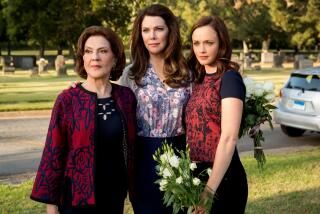Talking with Sara Shepard about ‘Pretty Little Liars’
My 14-year-old daughter, Sophie, loves “Pretty Little Liars.” Both the novels by Sara Shepard and the ABC Family show that’s based on them. She follows it all, tracking differences in how the stories unfold, discussing it with her friends. So when Shepard recently published “Crushed” -- the 13th book in the series about four high school girls (Hanna, Spencer, Aria and Emily) and their ongoing battles with a dangerous antagonist known as A -- Sophie jumped at the chance to talk with her. We caught up with the author by phone from suburban Philadelphia, where she was raised and continues to live. Sophie asked the questions, and I took the notes.
The TV show of “Pretty Little Liars” is different than the books. Are you happy with the changes that have been made?
I am. I think it really works for TV. On the show, the four main characters are much better friends; in the books, they’re more apart, they keep secrets from each other. There are other changes: For instance, I had Mona die, but I think it’s cool that on the show she lived. The girls on the show remind me of the characters I write about, so whatever changes the producers want to make, I’m fine with it because they respect the spirit of the books.
You did a guest appearance on the show. Was it fun to interact with your characters?
I don’t think I even thought about it at the time, but yes, there is something interesting about coming face-to-face with the characters you created. Those girls, in some ways, are a lot like I was: arty, over the whole suburban scene, and wanting to get out into the world. So there’s some common ground there.
Do you have a favorite character?
I love all of them because they represent the way I was at their age. Spencer is an uptight, type-A personality, and Hanna cares a lot what people think and is heartbroken by her dad. My favorite character to write about, though, might be Ali; she really makes the story go. It’s both interesting to write about her and sometimes awful. But I like writing about mean girls because they stir things up.
Your characters all have issues, which makes them seem more real.
From the beginning of the series, I didn’t want to create characters who were perfect. In addition to her trouble with her father, Hanna has an eating disorder. Emily has sexuality issues, and her family is unsupportive. There’s also an overarching theme of bullying in the novels, which wasn’t in the news so much when I started “Pretty Little Liars” in 2006, but is very prominent now. So I do think about it. I get a lot of letters from readers, telling me they relate to the characters, and that means a lot to me. I want to reassure them that nobody is perfect and that we’re all struggling with stuff.
Did you ever think the series would go on for so many books?
At first, it was only going to be four books. Halfway through the second book, the publisher asked if I wanted to do more. So I started thinking about what I’d need to do to make that work. When the show started to do well, we began to talk about additional new books, and I got excited. At that point, I had finished book eight, and I was focusing on my other series, “The Lying Game.” But I really missed the “Pretty Little Liars” girls. Because I’d left book eight open-ended, I was really excited to write book nine.
How long do you plan for it to continue?
I’m working on book 14 right now, and there’s going to be a book 15 and book 16. Then I’m pretty sure that’s going to be the end. It’s been a lot of fun, and it’s hard for me to believe it’s going to be over, but I’d like to move on to something else. It’s tough to say, because the girls are such compelling characters. But I don’t want them to go to college. It seems like the right place to end.
ALSO:
Miranda July makes art out of writers’ emails
Neil Gaiman’s ‘Sandman’ returns on Vertigo this fall
Amy Gerstler and Alexis Smith discuss the art of collaboration
More to Read
Sign up for our Book Club newsletter
Get the latest news, events and more from the Los Angeles Times Book Club, and help us get L.A. reading and talking.
You may occasionally receive promotional content from the Los Angeles Times.









